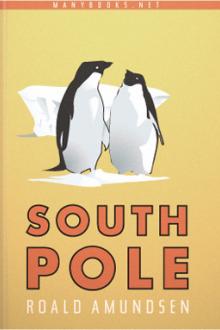The North Pole by Robert E. Peary (room on the broom read aloud .TXT) 📕

- Author: Robert E. Peary
- Performer: -
Book online «The North Pole by Robert E. Peary (room on the broom read aloud .TXT) 📕». Author Robert E. Peary
But all that is now as a tale that is told. This time it is a different and perhaps a more inspiring story, though the records of gallant defeat are not without their inspiration. And the point which it seems fit to make in the beginning is that success crowned the efforts of years because strength came from repeated defeats, wisdom from earlier error, experience from inexperience, and determination from them all.
Perhaps, in view of the striking manner in which the final event bore out the prophecies that I had made, it may be of interest to compare in some detail the plan of campaign that was announced, over two months before the Roosevelt sailed from New York on her final voyage to the North, with the manner in which that campaign was actually executed.
Early in May, 1908, in a published statement I sketched the following plan:
"I shall use the same ship, the Roosevelt; shall leave New York early in July; shall follow the same route north, via Sydney, C. B., Strait of Belle Isle, Davis Strait, Baffin Bay, and Smith Sound; shall use the same methods, equipments, and supplies; shall have a minimum party of white men, supplemented with Eskimos; shall take on these Eskimos and dogs in the Whale Sound region as before, and shall endeavor to force my ship to the same or similar winter quarters on the north shore of Grant Land as in the winter of 1905-1906.
"The sledge march will begin as before in February, but my route will be modified as follows: First, I shall follow the north coast of Grant Land as far west as Cape Columbia, and possibly beyond, instead of leaving this land at Point Moss as I did before.
"Second, leaving the land, my course will be more west of north than before, in order to counteract or allow for the easterly set of the ice between the north coast of Grant Land and the Pole, discovered on my last expedition. Another essential modification will be a more rigid massing of my sledge divisions en route, in order to prevent the possibility of a portion of the party being separated from the rest by the movement of the ice, with insufficient supplies for a protracted advance, as happened on the last expedition.
"There is no doubt in my mind that this 'big lead' (a lane of open water), encountered in both my upward and return marches in my last expedition, is an essentially permanent feature of this part of the Arctic Ocean. I have little doubt of my ability to make this 'lead,' instead of the north coast of Grant Land, my point of departure with fully loaded sledges. If this is done it will shorten the route to the Pole by nearly one hundred miles and distinctly simplify the proposition.
"On the return march in the next expedition I shall probably do voluntarily what I did involuntarily last time; that is, retreat upon the north coast of Greenland (a course diagonally with the set of the ice) instead of attempting to come back to the north coast of Grant Land (diagonally against the set of the ice). An adjunct of this program will probably be the establishment of a depot well up the north coast of Greenland by the first of the supporting parties returning to the ship."
The main features of this program I summarized as follows:
"First, the utilization of the Smith Sound or 'American' route. This must be accepted to-day as the best of all possible routes for a determined, aggressive attack upon the Pole. Its advantages are a land base one hundred miles nearer the Pole than is to be found at any other point of the entire periphery of the Arctic Ocean, a long stretch of coast line upon which to return, and a safe and (to me) well-known line of retreat independent of assistance, in the event of any mishap to the ship.
"Second, the selection of a winter base which commands a wider range of the central polar sea and its surrounding coasts than any other possible base in the Arctic regions. Cape Sheridan is practically equidistant from Crocker Land, from the remaining unknown portion of the northeast coast of Greenland, and from my 'Nearest the Pole' of 1906.
"Third, the use of sledges and Eskimo dogs. Man and the Eskimo dog are the only two machines capable of such adjustment as to meet the wide demands and contingencies of Arctic travel. Airships, motor cars, trained polar bears, etc., are all premature, except as a means of attracting public attention.
"Fourth, the use of the hyperborean aborigine (the Whale Sound Eskimo) for the rank and file of the sledge party. It seems unnecessary to enlarge upon the fact that the men whose heritage is life and work in that very region must present the best obtainable material for the personnel of a serious Arctic party. This is my program. The object of the work is the clearing up, or at least the fixing in their general proportions, of the remaining large problems in the American segment of the polar regions and the securing for the United States of that great world trophy which has been the object of effort and emulation among practically all the civilized nations of the world for the last three centuries."
The details of this plan have been here set forth so explicitly because the faithfulness with which they were carried out constitutes a record which is perhaps unique in the annals of Arctic exploration. Compare this scheme, if you please, with the manner of its execution. As had been planned, the expedition sailed from New York early in July, 1908, July 6, to be exact. It sailed from Sydney July 17, from Etah August 18, and arrived at Cape Sheridan, the winter quarters of the Roosevelt, on September 5, within a quarter of an hour of the same time it had arrived at the same spot three years before. The winter was occupied in hunting, in various side journeys, in making our sledging equipment, and in moving supplies from the Roosevelt along the northern shore of Grant Land to Cape Columbia, which was to be our point of departure from the land on our drive for the Pole itself.
The sledge divisions left the Roosevelt from February 15 to 22, 1909, rendezvoused at Cape Columbia, and on March 1 the expedition left Cape Columbia, heading across the Polar Ocean for the Pole. The 84th parallel was crossed on March 18, the 86th on March 23, the Italian record was passed the next day, the 88th parallel on April 2, the 89th on April 4, and the North Pole was reached on April 6 at ten o'clock in the morning. I spent thirty hours at the Pole with Matt Henson, Ootah, the faithful Eskimo who had gone with me in 1906 to 87° 6´, the then "farthest north," and three other Eskimos who had also been with me on previous expeditions. The six of us left the much desired "ninety north" on April 7 on the return journey and reached land at Cape Columbia again on April 23.
It will be noted that while the journey from Cape Columbia to the Pole consumed thirty-seven days, (though only twenty-seven marches) we returned from the Pole to Cape Columbia in only sixteen days. The extraordinary speed of the return journey is to be accounted for by the fact that we merely had to retrace our old trail instead of making a new one, and because we were fortunate in encountering no delays. Excellent conditions of ice and weather also contributed, not to mention the fact that the exhilaration of success lent wings to our sorely battered feet. But Ootah, the Eskimo, had his own explanation. Said he: "The devil is asleep or having trouble with his wife, or we should never have come back so easily."
It will be noted in this comparison, that practically the only feature of the plan from which essential deviation was made was in returning to Cape Columbia on the coast of Grant Land instead of further eastward to the northern coast of Greenland as I had done in 1906. This change was made for excellent reasons, which will be made clear in their proper place. Upon this record there is only one shadow—a tragic one indeed. I refer, of course, to the lamentable death of Prof. Ross G. Marvin, who was drowned on April 10, four days after the Pole had been reached, forty-five miles north of Cape Columbia, while returning from 86° 38´ north, in command of one of the supporting parties. With this sad exception, the history of the expedition is flawless. We returned as we went, in our own ship, battered but unharmed, in excellent health and with a record of complete success.
There is a lesson in all this—a lesson so obvious that it is perhaps superfluous to point it out. The plan, so carefully made and executed with such faithfulness to detail, was composed of a number of elements, the absence of any one of which might have been fatal to success. We could scarcely have succeeded without the help of our faithful Eskimos; nor even with them, had it not been for our knowledge of their capacities for work and endurance, and for the confidence which years of acquaintance had taught them to repose in me. We could certainly not have succeeded without the Eskimo dogs which furnished the traction power for our sledges, and so enabled us to carry our supplies where no other power on earth could have moved them with the requisite speed and certainty. It may be that we could not have succeeded without the improved form of sledge which I was able to construct and which, combining in its construction, strength, lightness, and ease of traction, made the heavy task of the dogs far easier than it would otherwise have been. It may even be that we should have failed had it not been for so simple a thing as an improved form of water boiler which I was fortunate enough to have hit upon. By its aid we were able to melt ice and make tea in ten minutes. On our previous journeys this process had taken an hour. Tea is an imperative necessity on such a driving journey, and this little invention saved one and one-half hours in each day while we were struggling toward the Pole on that journey when time was the very essence of success.
Success crowned the work, it is true, but, for all that, it is a genuine pleasure to reflect that even had we failed, I should have had nothing to reproach myself with in the way of neglect. Every possible contingency that years of experience had taught me to expect was provided for, every weak spot guarded, every precaution taken. I had spent a quarter of a century playing the Arctic game. I was fifty-three years old, an age beyond which, perhaps, with the one exception of Sir John Franklin, no man had ever attempted to prosecute work in the Arctic regions. I was a little past the zenith of my strength, a little lacking, perhaps, in the exuberant elasticity and élan of more





Comments (0)